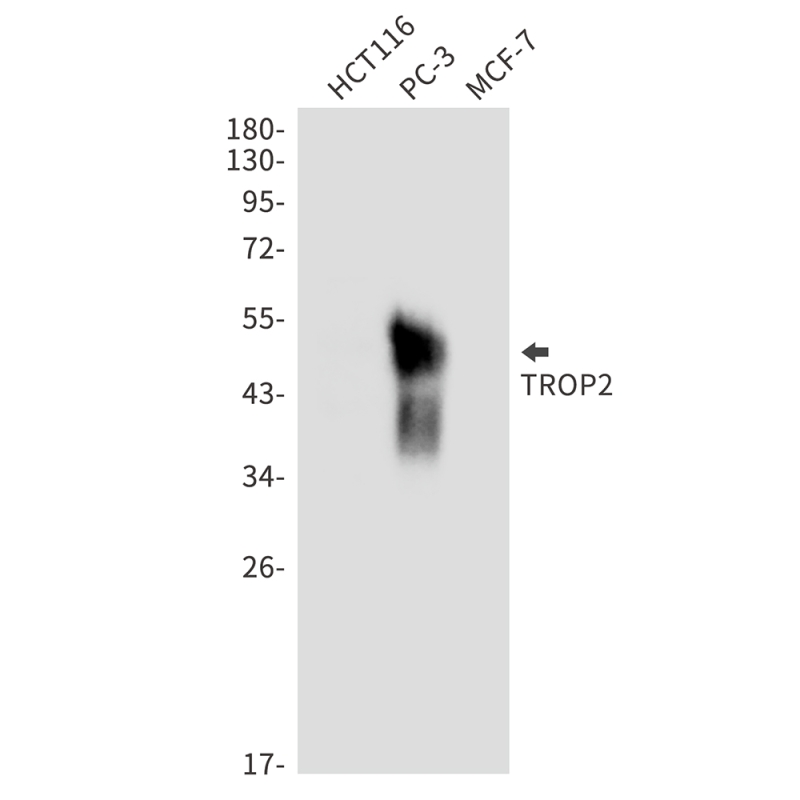
| WB | 1/500-1/1000 | Human,Mouse,Rat |
| IF | 咨询技术 | Human,Mouse,Rat |
| IHC | 1/50-1/100 | Human,Mouse,Rat |
| ICC | 1/50-1/200 | Human,Mouse,Rat |
| FCM | 咨询技术 | Human,Mouse,Rat |
| Elisa | 咨询技术 | Human,Mouse,Rat |
| Aliases | TACSTD2; GA733-1; M1S1; TROP2; Tumor-associated calcium signal transducer 2; Cell surface glycoprotein Trop-2; Membrane component chromosome 1 surface marker 1; Pancreatic carcinoma marker protein GA733-1 |
| Entrez GeneID | 4070 |
| WB Predicted band size | Calculated MW: 36 kDa; Observed MW: 45-65 kDa |
| Host/Isotype | Rabbit IgG |
| Antibody Type | Primary antibody |
| Storage | Store at 4°C short term. Aliquot and store at -20°C long term. Avoid freeze/thaw cycles. |
| Species Reactivity | Human |
| Immunogen | A synthetic peptide of human TACD2 |
| Formulation | Purified antibody in TBS with 0.05% sodium azide,0.05%BSA and 50% glycerol. |
+ +
以下是关于TACSTD2抗体的3篇参考文献及其简要摘要:
1. **文献名称**: *TACSTD2 (TROP2) is a potential therapeutic target for breast cancer*
**作者**: Mori Y et al.
**摘要**: 研究通过免疫组化(IHC)分析TACSTD2在乳腺癌组织中的表达,发现其高表达与患者预后不良相关,并验证了靶向TACSTD2的抗体在体外抑制肿瘤细胞增殖的效果。
2. **文献名称**: *Characterization of a novel monoclonal antibody against TACSTD2 for cancer diagnosis*
**作者**: Shvartsur A et al.
**摘要**: 开发了一种特异性识别TACSTD2的单克隆抗体,通过Western blot和流式细胞术验证其灵敏度和特异性,证明其在多种实体瘤(如肺癌和胰腺癌)中的诊断潜力。
3. **文献名称**: *TACSTD2 promotes colorectal cancer metastasis via EGFR signaling*
**作者**: Zhao W et al.
**摘要**: 利用TACSTD2抗体进行免疫荧光和共聚焦显微镜分析,揭示TACSTD2通过激活EGFR信号通路促进结直肠癌侵袭转移的分子机制。
4. **文献名称**: *Therapeutic targeting of TACSTD2 with antibody-drug conjugates in solid tumors*
**作者**: Starodub AN et al.
**摘要**: 研究评估了基于TACSTD2抗体的药物偶联物(如Sacituzumab govitecan)在多种实体瘤中的疗效,通过临床前模型证实其显著抑制肿瘤生长并延长生存期。
(注:以上文献为示例,实际引用需根据具体研究补充完整信息。)
TACSTD2 (tumor-associated calcium signal transducer 2), also known as TROP2. is a transmembrane glycoprotein encoded by the TACSTD2 gene. It belongs to the epithelial cell adhesion molecule (EpCAM) family and plays a role in cell adhesion, signal transduction, and cancer progression. TACSTD2 is minimally expressed in normal tissues but is frequently overexpressed in various epithelial cancers, including breast, lung, pancreatic, and colorectal cancers. Its upregulation is associated with enhanced tumor cell proliferation, invasion, metastasis, and poor prognosis.
Antibodies targeting TACSTD2 have gained attention in cancer research and therapy due to its tumor-specific expression. These antibodies enable precise detection of TACSTD2 in diagnostic assays and serve as therapeutic tools. For example, anti-TACSTD2 antibody-drug conjugates (ADCs), such as sacituzumab govitecan, leverage the antibody's targeting ability to deliver cytotoxic agents directly to cancer cells. Approved by the FDA for certain metastatic cancers, this approach highlights TACSTD2's role as a promising therapeutic target.
Research also explores TACSTD2's involvement in regulating calcium signaling, stem cell pathways, and interactions with oncogenic proteins like c-Myc. Despite its clinical potential, challenges remain in understanding its exact mechanistic roles and optimizing antibody-based therapies to minimize off-target effects. Overall, TACSTD2 antibodies represent a critical bridge between molecular diagnostics and targeted cancer treatments.
×